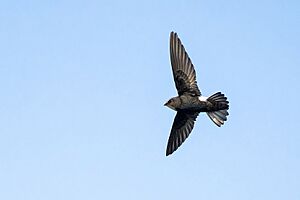House swift facts for kids
Quick facts for kids House swift |
|
|---|---|
 |
|
| Flying in Shivapuri Nagarjun National Park, Nepal | |
| Conservation status | |
| Scientific classification | |
| Genus: |
Apus
|
| Species: |
nipalensis
|
The house swift (Apus nipalensis) is a type of swift bird. It belongs to the Apodidae family. You can find these birds in countries like Japan, Nepal, and across Southeast Asia. House swifts are amazing flyers! They can fly for a very long time by resting one side of their brain while the other side stays awake.
This bird was once thought to be a subspecies of the little swift. It was known as Apus affinis subfurcatus back then.
Contents
What Does a House Swift Look Like?
The house swift looks a lot like the little swift. It is a small bird, but it's a medium-sized swift. Its wings can spread out about 12.5 to 14.5 centimeters wide. The bird's body is usually between 14 and 16 centimeters long. It weighs around 20 to 35 grams.
This swift has a dark tail that is slightly forked, meaning it splits a little at the end. Most of its feathers are black. It also has a white band on its lower back and a white patch on its throat. Its black feathers are darker than those of the little swift.
Where Do House Swifts Live?
House swifts spend most of their time flying in the air. They catch their food while soaring high above. You can generally find these birds across the continent of Asia. Different groups, called subspecies, live in slightly different areas.
- The Apus nipalensis nipalensis group lives from Nepal all the way to Southeastern China. They are also found in Japan and parts of Southeast Asia.
- The Apus nipalensis subfurcatus group lives in the Malay Peninsula. They are also found on other islands in Southeast Asia.
- The Apus nipalensis furcatus group makes its home on the islands of Java and Bali in Indonesia.
- The Apus nipalensis kuntzi group lives only on the island of Taiwan.
House swifts live in both cities and natural areas in Asia. They have been seen in the mountains of Nepal. They also live in towns and cities in places like China, Vietnam, and Hong Kong. Once, a house swift was found in North America in 2012. Scientists used DNA to confirm it was a house swift. However, this sighting was not officially accepted because the bird was already dead when it was found.
House Swift Behavior
House swifts build their nests in two main places. They either nest on cliffs or in urban areas. When they nest in cities, they often choose spots under the roofs of buildings. They also like to nest inside tunnels. Many house swifts build their nests on cliffs on islands near Vietnam.
These birds build their nests using their own saliva. They stick together leaves, small branches, and feathers with their sticky spit. Their nests can look a bit messy!
Reproduction and Life Cycle
House swifts usually have one breeding season each year. During this time, they often raise two sets of chicks. The first time they lay eggs takes about three weeks. By early June, all the young birds from the first group have learned to fly.
A few weeks later, the second group of eggs hatches. The last young birds leave their nests by mid-September. A female swift can lay anywhere from one to five eggs at a time. The eggs take about 20 to 30 days to hatch.
What Do House Swifts Eat?
Like many other swifts and swallows, house swifts catch their food while flying. They mostly eat tiny creatures that float in the air. Scientists studied their droppings and found that their diet is almost entirely made up of arthropods. This group of creatures includes ants, spiders, mosquitoes, and flies, among many others.
House Swift Sounds
House swifts make different sounds. One common call they make sounds like ti-ti-ti-tititrrrrrr.
Do House Swifts Migrate?
Scientists have not studied the migration of house swifts very much. However, they have been seen in Northern Australia and India. This suggests that some house swifts move to warmer places during the winter months.


